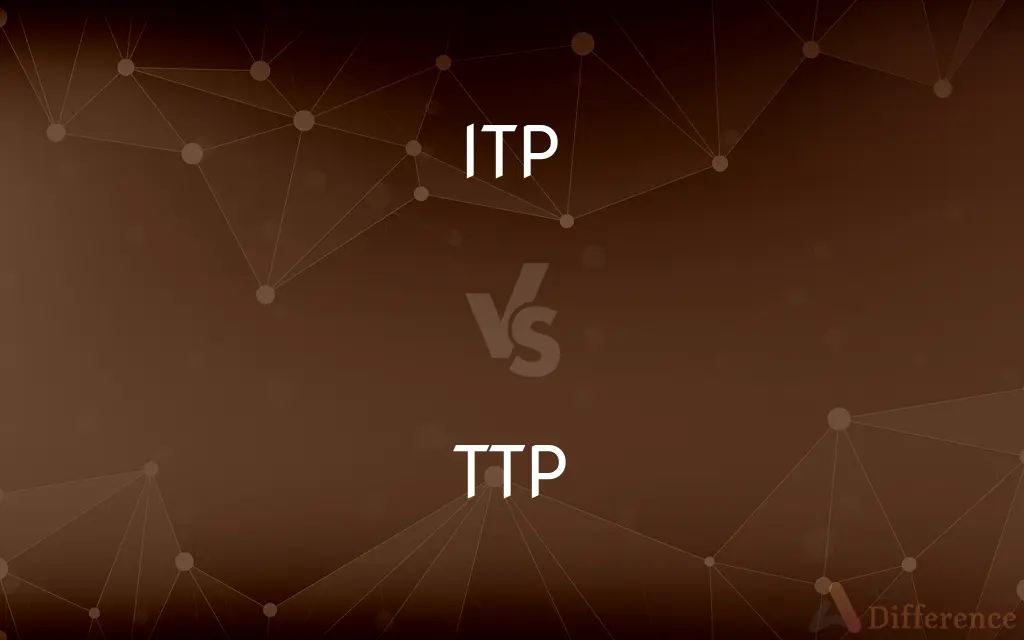ITP vs. TTP — What's the Difference?
By Tayyaba Rehman — Published on January 24, 2024
ITP (Idiopathic Thrombocytopenic Purpura) is a bleeding disorder due to low platelet count, while TTP (Thrombotic Thrombocytopenic Purpura) involves blood clots and platelet consumption.

Difference Between ITP and TTP
Table of Contents
ADVERTISEMENT
Key Differences
ITP, or Idiopathic Thrombocytopenic Purpura, is a condition characterized by an abnormally low level of platelets, leading to easy bruising and bleeding. TTP, or Thrombotic Thrombocytopenic Purpura, is a rarer disorder where small blood clots form in blood vessels, using up platelets and leading to a similar low platelet count.
The cause of ITP is often unknown, hence 'idiopathic,' and it is thought to be an immune response gone awry. In contrast, TTP is caused by a deficiency of an enzyme called ADAMTS13, leading to abnormal blood clot formation.
Symptoms of ITP can include excessive bruising, bleeding, and petechiae (small red spots under the skin). TTP symptoms are more severe, including the above plus fever, kidney malfunction, and neurological symptoms like confusion.
Treatment for ITP often involves steroids, immunoglobulins, or splenectomy in chronic cases. TTP requires urgent treatment with plasma exchange and immunosuppressive medications.
ITP can affect individuals of any age but is more common in children and adults over 60. TTP, while rare, can be life-threatening and often requires immediate medical attention.
ADVERTISEMENT
Comparison Chart
Primary Concern
Low platelet count due to immune dysfunction
Blood clots in vessels, leading to platelet consumption
Cause
Often unknown, immune-related
Deficiency of ADAMTS13 enzyme
Common Symptoms
Bruising, bleeding, petechiae
Bruising, bleeding, petechiae, fever, neurological issues
Treatment
Steroids, immunoglobulins, splenectomy
Plasma exchange, immunosuppressives
Typical Onset
Any age, common in children and older adults
Can occur at any age, requires urgent attention
Compare with Definitions
ITP
Often idiopathic with an immune system-related cause.
The cause of his ITP was unknown, suggesting an autoimmune origin.
TTP
A rare disorder with blood clots in small vessels.
TTP was suspected due to her symptoms of blood clots and low platelets.
ITP
A bleeding disorder characterized by low platelet count.
After being diagnosed with ITP, she noticed increased bruising.
TTP
Caused by a deficiency of the ADAMTS13 enzyme.
Her TTP was linked to a severe deficiency in the ADAMTS13 enzyme.
ITP
More common in children and adults over 60.
ITP is often diagnosed in children presenting with unusual bleeding.
TTP
Symptoms include fever, neurological issues, and kidney problems.
He showed signs of TTP, including confusion and fever.
ITP
Can manifest as excessive bruising and bleeding.
Excessive bruising led to the diagnosis of ITP.
TTP
Requires urgent treatment like plasma exchange.
She was immediately treated with plasma exchange for TTP.
ITP
Treatable with steroids or immunoglobulins.
Her ITP improved after starting steroid therapy.
TTP
Can be life-threatening and requires immediate medical attention.
Due to the severity of TTP, he was quickly hospitalized.
Common Curiosities
What does TTP stand for?
TTP stands for Thrombotic Thrombocytopenic Purpura.
How is TTP different from ITP?
TTP involves blood clot formation in small vessels, consuming platelets, while ITP is characterized by immune-mediated destruction or decreased production of platelets.
What are common symptoms of ITP?
Common symptoms of ITP include easy bruising, bleeding gums, and petechiae.
Are there any long-term effects of TTP?
TTP can have long-term effects, including neurological issues and kidney damage, if not treated promptly.
Are both ITP and TTP autoimmune disorders?
ITP is often considered an autoimmune disorder, while TTP is related to a specific enzyme deficiency and is not typically classified as autoimmune.
What triggers TTP?
TTP is often triggered by a deficiency in the ADAMTS13 enzyme, leading to abnormal blood clot formation.
Is the cause of ITP always known?
No, the cause of ITP is often idiopathic, meaning it is unknown.
What does ITP stand for?
ITP stands for Idiopathic Thrombocytopenic Purpura.
What is the main characteristic of ITP?
The main characteristic of ITP is a low platelet count leading to bleeding and bruising.
How is TTP treated?
TTP is treated with plasma exchange and immunosuppressive medications.
What is the treatment for ITP?
Treatments for ITP may include steroids, immunoglobulins, or splenectomy in chronic cases.
Can ITP and TTP be cured?
While ITP can often be managed effectively with treatment, it may not be completely curable. TTP requires immediate treatment and can be controlled, but the underlying propensity may remain.
Can children be affected by ITP?
Yes, ITP can affect children, often manifesting as sudden bruising and bleeding.
Is TTP a life-threatening condition?
Yes, TTP can be life-threatening and requires immediate medical attention.
Can ITP lead to severe bleeding?
Yes, ITP can lead to severe bleeding due to the significantly reduced platelet count.
Share Your Discovery

Previous Comparison
Microsoft Xbox One S vs. Microsoft Xbox One X
Next Comparison
Lap Winding vs. Wave WindingAuthor Spotlight
Written by
Tayyaba RehmanTayyaba Rehman is a distinguished writer, currently serving as a primary contributor to askdifference.com. As a researcher in semantics and etymology, Tayyaba's passion for the complexity of languages and their distinctions has found a perfect home on the platform. Tayyaba delves into the intricacies of language, distinguishing between commonly confused words and phrases, thereby providing clarity for readers worldwide.













































